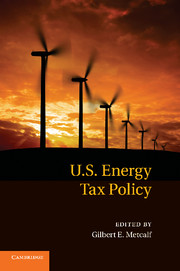Book contents
- Frontmatter
- Contents
- Conference Participants
- 1 Introduction
- 2 Distributional Impacts of Carbon Pricing Policies in the Electricity Sector
- 3 Distributional Impacts of a U.S. Greenhouse Gas Policy
- 4 Instrument Choice Is Instrument Design
- 5 Taxes, Permits, and Climate Change
- 6 Border Adjustments for Carbon Taxes and the Cost of Emissions Permits
- 7 Taxes and Caps as Climate Policy Instruments with Domestic and Imported Fuels
- 8 How Much Should Highway Fuels Be Taxed?
- 9 State Tax Policy and Oil Production
- 10 The Social Costs and Benefits of U.S. Biofuel Policies with Preexisting Distortions
- Index
- References
5 - Taxes, Permits, and Climate Change
Published online by Cambridge University Press: 01 June 2011
- Frontmatter
- Contents
- Conference Participants
- 1 Introduction
- 2 Distributional Impacts of Carbon Pricing Policies in the Electricity Sector
- 3 Distributional Impacts of a U.S. Greenhouse Gas Policy
- 4 Instrument Choice Is Instrument Design
- 5 Taxes, Permits, and Climate Change
- 6 Border Adjustments for Carbon Taxes and the Cost of Emissions Permits
- 7 Taxes and Caps as Climate Policy Instruments with Domestic and Imported Fuels
- 8 How Much Should Highway Fuels Be Taxed?
- 9 State Tax Policy and Oil Production
- 10 The Social Costs and Benefits of U.S. Biofuel Policies with Preexisting Distortions
- Index
- References
Summary
Introduction
Kaplow and Shavell (2002) offer a systematic critique of the view associated with Weitzman (1974) that the choice between corrective taxes and quantity targets is highly contingent in a world of uncertainty. They emphasize that this conventional understanding, heavily represented in texts and surveys on environmental economics as well as in more general textbooks, rests on a poorly appreciated and dubious set of assumptions.
First, in the Weitzman story, taxes are constrained to be linear, even though marginal harm is taken to be nonlinear (typically, rising in the quantity of emissions), so the Weitzman tax instrument violates the basic Pigouvian prescription that the marginal tax rate equal marginal harm. Second, taxes are taken to be fixed for all time, even though any error in setting the (constrained-to-be-linear) tax rate would become immediately apparent to the government. Relaxing either assumption restores the superiority of taxes over quantity regulation. Moreover, neither assumption was well motivated by Weitzman or in the subsequent literature. Nonlinear taxes are simple to state in many settings, and tax rates (really prices) of all sorts – whether set by government or the market – are routinely adjusted in response to changed circumstances.
Second, Kaplow and Shavell (2002) extend their analysis to permit schemes. On one hand, this instrument has the familiar and important advantage over command-and-control quantity regulation that a given quantity target is achieved at minimum cost. On the other hand, like familiar schemes, the quantity is set by fiat, once and for all.
- Type
- Chapter
- Information
- US Energy Tax Policy , pp. 168 - 192Publisher: Cambridge University PressPrint publication year: 2010
References
- 4
- Cited by



